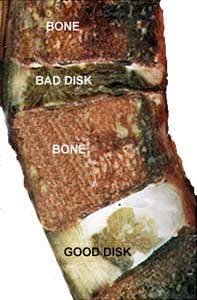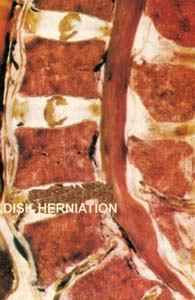
Often in younger cases, a dramatic spine loading incident precipitates a herniation of disk material out of the disk space unto the nerve that is leaving the spine at that level. In older cases commonly, bone spurs and settling of the vertebra result in the emerging nerve getting pinched in the spinal exit hole at the same level. In intermediate ages both effects can combine to cause compression of the exiting nerve. If nerve compression occurs, usually the affected nerve will report pain along its course down the leg and will cause back stiffness to increase locally as a reflex. If this nerve compression continues or becomes more severe, the nerve will malfunction and stop carrying proper signals for sensation and motor control resulting in varying degrees of numbness, tingling, weakness, twitching, or spasms. If the affected nerve does not receive relief at this advanced stage, there is an increasing risk that the nerve will die and that its muscles will atrophy away. Nerves are soft like spaghetti noodles and canít function properly or repair themselves while they are being compressed.

 |
 |
